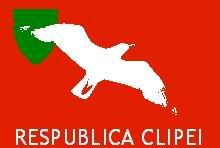Gull Flag Revolution

|
The period of time known as the Gull Flag Revolution is generally considered to coincide with Iansisle’s Corporate Yoke. However, the start of the Revolution - the Grand Street Massacre - actually preceded the Yoke by more than a fortnight.
The Massacre occurred on 5 December 1951 when Royal Mining and Manufacturing instigators hid among striking workers in RM&M’s Grand Street Steel Works and fired into units of the King’s IV Rifles, which was keeping an eye on the proceedings. The soldiers returned fire and forty-seven unarmed workers were gunned down. The leader of the strike, Lawrence Madders, was arrested and exiled to the Divine Imperium on pain of death. On 21 December, RM&M and other forces occupied Jameston Place and took control of the government.
However, the corporates plan backfired; the increasingly violent breaking of strikes led many of Ianapalis’ underclasses to take up arms, until the capital city had essentially to be occupied. However, resistance was disorganized in the beginning and the corporate forces had gained the upper hand by April 1952, despite some slight news leaks to the outside world.
Sometime in late April or early May 1952, the government of the Divine Imperium learned of the troubles in Ianapalis. It was decided that Madders, currently living there in exile, would prove a perfect catalyst to force the ultimate demise of the Grand Empire of the Shield. In a scene reminiscent of Lenin’s sealed train, Madders was shipped back to Ianapalis and left to his own devices.
Lawrence Madders, despite his pretensions, was not the leader the revolution needed. His time away from the Shield had seen him become increasingly radical; many local leaders distrusted his republican and anti-royalist agenda. Even in these dark hours, the revolutionaries harbored loyalties to the crown and identified only the corporations as evil. The revolution continued to lose momentum.
More news did escape the political blockade, however, especially after crown-loyalist the Earl of Inswick had his son try to smuggle a message to President Jeff Williams of Larkinia. Although Williams’ subsequent trip to Dûn Ádien proved inconclusive, the news did resonate with Charles Bradsworth, former soapbox orator and current Ambassador to the Alliance of the New Highlands.
As soon as rumors to the extent of the disturbances on the Shield reached the Alliance Headquarters in Golden Agate, Bradsworth formulated a plan. On 4 June 1952, Bradsworth gave his assistant a falsified document, sealed with a forged copy of Lord Inswick’s ring, that reported Iansisle wished to cancel its duties as a member of the Alliance. In the resulting confusion, Bradsworth slipped back to Ianapalis.
Bradsworth’s famed mellifluous oratory and his conservative stance (compared to Madders, at least) soon won much support among the other revolutionary leaders. Soon, most had united under Bradsworth’s chosen banner - a crudely drawn, white, spread-winged gull soaring over a green shield on a red background with the Latin inscription ‘RESPUBLICA CLIPEI’ underneath - and the movement began to gather headway.
3 August 1952 would prove to be the key date; with the (now called) Gull Flaggers threatening Sarawak Street, the corporates made the decision to pull out of Ianapalis. Bradsworth’s forces swarmed in the wake of the withdrawing troops and had soon occupied the entire western half of the city.
Meanwhile, a party under Sir Richard Tri had attempted to rescue High King James III from where the corporates had stashed him in #5 Jameston Place. However, Sir Richard was killed in a duel with William Ashtonbury, a Company officer attempting to move the High King out of the city, and the party was delayed long enough for Bradsworth’s forces to breach the last-stand corporate forces holding Sarawak Street.
James and the remainder of the party attempted to reach the harbor, where the battleship Princess Royal had appeared and was disembarking her company of marines, but they were cutoff by Bradsworth and taken deeper into the city. Rather than renew hostilities, however, Bradsworth decided to negotiate with the Princess Royal’s commander, Sir James Redford, who had the reputation of the most liberal officer in the fleet.
Late in the night on 3 August - some say it was technically 4 August - Bradsworth, James, and Redford struck a compromise. The old Grand Empire was to be disbanded, those responsible for the Corporate Yoke arrested and their companies nationalized, and a constitution to be drafted; however, the monarchy and peerage would be retained, with James remaining as nominal head of state. The Grand Empire was restyled the ‘United Kingdom of the Shield’ and Bradsworth almost unanimously declared Premier-Interim - something which doubtlessly vexed the only nay vote, Lawrence Madders, to no end. A new chapter in Iansislean history was thus opened.
